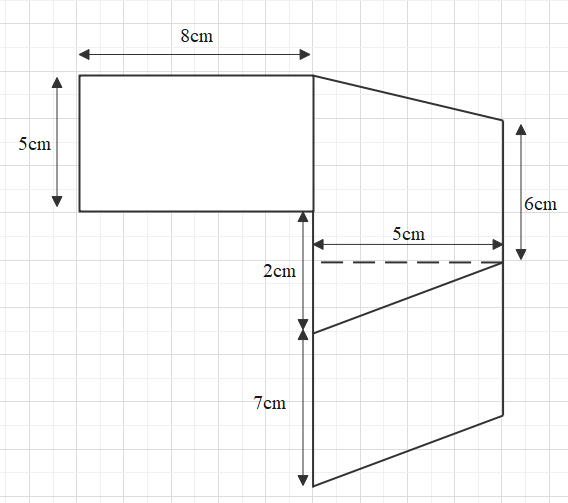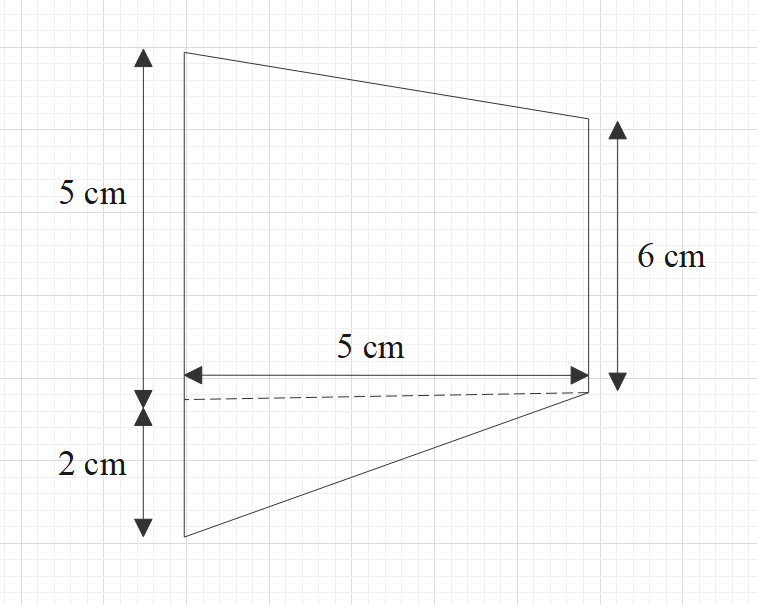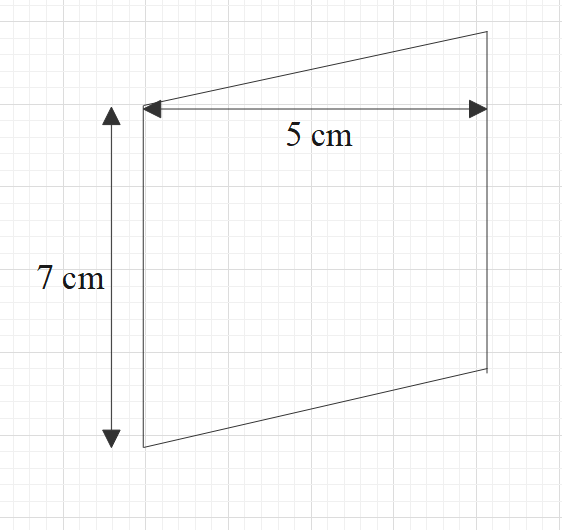
Find the area of the following figure.


Answer
569.7k+ views
Hint: We have a figure consisting of a rectangle, trapezium, and a parallelogram. We need to find the area of the figure given. So, firstly find the area of rectangle, trapezium, and parallelogram. The formula to find the area of different shapes is given as:
Area of rectangle: ${{A}_{R}}=\left( l\times b \right)$
Area of trapezium: ${{A}_{T}}=\dfrac{1}{2}\times \left( \text{sum of parallel sides} \right)\times \left( \text{height} \right)$
Area of parallelogram: ${{A}_{P}}=\dfrac{1}{2}\times \left( \text{base} \right)\times \left( \text{height} \right)$
Complete step by step answer:
We have a figure consisting of various shapes. So, let us divide them and note down their dimensions.
First, we have a rectangle:

Length = 8 cm
Breadth = 5 cm
Next, we have a trapezium:

Height = 5 cm
Side 1 = 7 cm
Side 2 = 6 cm
The last shape we have is a parallelogram:

Base = 7 cm
Height = 5 cm
So, the area of figure = area of rectangle + area of trapezium + area of parallelogram
i.e. $A={{A}_{R}}+{{A}_{T}}+{{A}_{P}}......(1)$
As we know that: Area of rectangle: ${{A}_{R}}=\left( l\times b \right)$
So, we have:
$\begin{align}
& {{A}_{R}}=\left( 8\times 5 \right) \\
& =40c{{m}^{2}}......(2)
\end{align}$
Area of trapezium: ${{A}_{T}}=\dfrac{1}{2}\times \left( \text{sum of parallel sides} \right)\times \left( \text{height} \right)$
So, we have:
$\begin{align}
& {{A}_{T}}=\dfrac{1}{2}\times \left( 7+6 \right)\times 5 \\
& =32.5c{{m}^{2}}......(3)
\end{align}$
Area of parallelogram: ${{A}_{P}}=\dfrac{1}{2}\times \left( \text{base} \right)\times \left( \text{height} \right)$
So, we have:
$\begin{align}
& {{A}_{P}}=\dfrac{1}{2}\times 7\times 5 \\
& =17.5c{{m}^{2}}......(4)
\end{align}$
So, the area of figure is:
$\begin{align}
& A=40+32.5+17.5 \\
& =90c{{m}^{2}}
\end{align}$
Note: It is easier to divide a complex figure into small identifiable figures whose area can be calculated. As for the given figure, it is difficult to tabulate the area of the whole figure, because we do not have a predefined formula for the area of such a complex figure. But when we divided the figure into various small figures that are easily identified, i.e. rectangle, trapezium, and parallelogram. We have the formula for calculating the area of these small figures. So, we can calculate the area of the whole figure by adding all the areas of other small shapes or figures.
Area of rectangle: ${{A}_{R}}=\left( l\times b \right)$
Area of trapezium: ${{A}_{T}}=\dfrac{1}{2}\times \left( \text{sum of parallel sides} \right)\times \left( \text{height} \right)$
Area of parallelogram: ${{A}_{P}}=\dfrac{1}{2}\times \left( \text{base} \right)\times \left( \text{height} \right)$
Complete step by step answer:
We have a figure consisting of various shapes. So, let us divide them and note down their dimensions.
First, we have a rectangle:

Length = 8 cm
Breadth = 5 cm
Next, we have a trapezium:

Height = 5 cm
Side 1 = 7 cm
Side 2 = 6 cm
The last shape we have is a parallelogram:

Base = 7 cm
Height = 5 cm
So, the area of figure = area of rectangle + area of trapezium + area of parallelogram
i.e. $A={{A}_{R}}+{{A}_{T}}+{{A}_{P}}......(1)$
As we know that: Area of rectangle: ${{A}_{R}}=\left( l\times b \right)$
So, we have:
$\begin{align}
& {{A}_{R}}=\left( 8\times 5 \right) \\
& =40c{{m}^{2}}......(2)
\end{align}$
Area of trapezium: ${{A}_{T}}=\dfrac{1}{2}\times \left( \text{sum of parallel sides} \right)\times \left( \text{height} \right)$
So, we have:
$\begin{align}
& {{A}_{T}}=\dfrac{1}{2}\times \left( 7+6 \right)\times 5 \\
& =32.5c{{m}^{2}}......(3)
\end{align}$
Area of parallelogram: ${{A}_{P}}=\dfrac{1}{2}\times \left( \text{base} \right)\times \left( \text{height} \right)$
So, we have:
$\begin{align}
& {{A}_{P}}=\dfrac{1}{2}\times 7\times 5 \\
& =17.5c{{m}^{2}}......(4)
\end{align}$
So, the area of figure is:
$\begin{align}
& A=40+32.5+17.5 \\
& =90c{{m}^{2}}
\end{align}$
Note: It is easier to divide a complex figure into small identifiable figures whose area can be calculated. As for the given figure, it is difficult to tabulate the area of the whole figure, because we do not have a predefined formula for the area of such a complex figure. But when we divided the figure into various small figures that are easily identified, i.e. rectangle, trapezium, and parallelogram. We have the formula for calculating the area of these small figures. So, we can calculate the area of the whole figure by adding all the areas of other small shapes or figures.
Recently Updated Pages
Two men on either side of the cliff 90m height observe class 10 maths CBSE

What happens to glucose which enters nephron along class 10 biology CBSE

Cutting of the Chinese melon means A The business and class 10 social science CBSE

Write a dialogue with at least ten utterances between class 10 english CBSE

Show an aquatic food chain using the following organisms class 10 biology CBSE

A circle is inscribed in an equilateral triangle and class 10 maths CBSE

Trending doubts
Why is there a time difference of about 5 hours between class 10 social science CBSE

Write a letter to the principal requesting him to grant class 10 english CBSE

What is the median of the first 10 natural numbers class 10 maths CBSE

The Equation xxx + 2 is Satisfied when x is Equal to Class 10 Maths

Which of the following does not have a fundamental class 10 physics CBSE

State and prove converse of BPT Basic Proportionality class 10 maths CBSE




